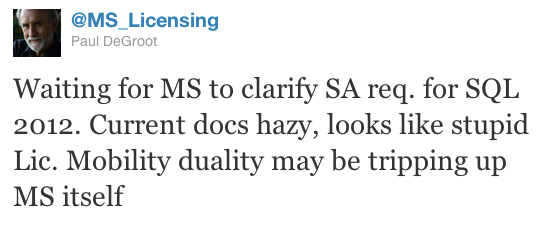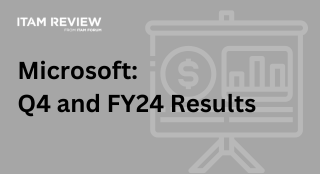Microsoft SQL 2012 Licensing Changes - Time to Get Control of Virtualized SQL
Great conversations were had at the UK SAM Networking event this week at Covent Garden. Connect with either Ian Preskett, David Phillips or the BCS to join future sessions.
One popular topic was the recent changes to SQL licensing which are likely to affect many organizations.
An ITAM Review reader has kindly provided a brief synopsis of the changes. This is not licensing advice and is likely to change as the finer points are disseminated throughout the Microsoft partner network.
Keep an eye on Paul DeGroot of Pica Communications and Directions on Microsoft for clarity in plain english.
as follows:
“The changes for SQL Server 2012 are;
- Now only 3 editions of SQL Server; Standard, Business Intelligence and Enterprise
- Standard can be licensed either in server/ CAL (as it is now) or per core.
- Enterprise can only be licensed per core.
- Virtual Mobility is now a Software Assurance benefit. Previously it was included in the Product Use Rights as a base entitlement
- An SQL Server CAL will allow access to either standard or BI editions.
Conversion from CPU (currently defined as a physical processor or Socket) to Cores will be done on the basis of:
- Current deployments, with a minimum of 4 cores per CPU for existing Standard and Enterprise licenses, and 8 for Datacentre edition or
- If licenses aren’t deployed, 4 cores per CPU for existing Standard and Enterprise licenses, and 8 for Datacentre edition. I believe the new pricing will be reflective of these ratios, but don’t have any more details now.
In itself, the move from CPU to core and the consolidation to three products are major changes. The removal of an existing license right for Virtual Mobility is a huge change, and will cause issue for anyone with virtualized SQL Servers some problems.
An extreme example would be a customer with
- an existing VMWare farm of 200 CPUs with 800 cores in 2 locations within the UK.
- 10 SQL Servers, currently using 20 Virtual CPUs that use VMotion with no limits on where the server can move to. This would currently require 20 SQL Server Standard CPU licenses
Without any changes to their infrastructure, this customer would potentially need to buy 800 Core licenses to cover their deployments to guarantee compliance. This would be a tenfold increase in license costs. This is a simplified example; there are ways to mitigate this cost, but it does illustrate the problem.”
Further Reading…
- Microsoft SQL Server 2012 Licensing Overview [Microsoft.com]
- SQL 2012 – Pricing and Licensing Quick Look [LadyLicensingBlog]
- Microsoft SQL 2012 Licensing Changes [Rich Gibbons at Bechtle]
- Microsoft Unveils SQL Server 2012 Licensing and Pricing [Redmongmag.com]
- Revolutionary Changes to Microsoft SQL 2012 License Models [Flexera Software Blog]
If you have any comments or new news to add for the benefit of other readers please post a comment below.
I visit a PC recycling facility when in Vegas, and talk SQL Licensing when in Covent Garden, I really need to get out more! 🙂
Can’t find what you’re looking for?
More from ITAM News & Analysis
-
The Allure of the Cloud: What are We Chasing?
When I ask ITAM professionals about their transition to the cloud, the responses are often similar. “It wasn’t my decision.” It’s striking how many people feel this way—decisions about moving from on-premises solutions to the cloud ... -
The M&S Cyberattack: How IT Asset Management Can Make or Break Your Recovery
Marks & Spencer (M&S), the iconic UK retailer, recently became the latest high-profile victim of a devastating cyberattack. Fellow retailers The Co-Op and Harrods were also attacked. Recent reports suggest the rapid action at the Co-Op ... -
AI in ITAM: Insightful Signals from the Front Line
During our Wisdom Unplugged USA event in New York in March 2025, we engaged ITAM professionals with three targeted polling questions to uncover their current thinking on Artificial Intelligence—what concerns them, where they see opportunity, and ...
Podcast
ITAM training
Similar Posts
-
Microsoft Q3 Soars as AI and Azure Growth Fuels Market Gains
On the 30th April, Microsoft released its Q3 quarterly earnings report, exceeding expectations and igniting investor optimism. Investors had been keeping a watchful eye on Azure’s Cloud performance after Microsoft’s Q2 Cloud results fell short of ... -
The High Cost of Oracle Java: Managing Expenses and Operational Efficiency
For businesses reliant on Java, Oracle’s licensing model presents a formidable challenge. Once a freely available technology, Java has evolved into a costly necessity for enterprises, with licensing changes leading to widespread financial and operational concerns. ... -
Microsoft: June 2024 Q4 and FY24 Results
Microsoft Corp recently announced its June 2024 Q4 and FY24 end-of-year results. Looking at the overall results across all sectors, the total revenue for Microsoft increased by 16% to a total of $245.1 billion with a ... -
Adobe Sued by FTC for Unfair Selling Practices
The Federal Trade Commission has announced legal proceedings against Adobe and two of its senior executives for what it claims is misleading and complex terms and activities related to cancellation of software subscriptions. Section 8403 of ...





